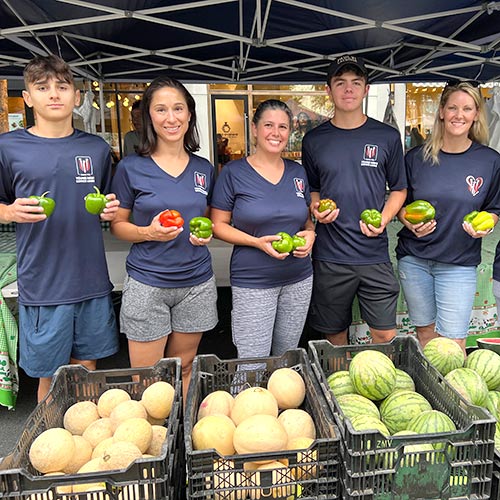FOOD AS MEDICINE: DIGESTIBLE BITES – August 2023
The shorter version:
- 60% of Americans do not eat food they would describe as very nutritious due to physical and economic barriers
- A report lists four challenges to the food as medicine movement including resistance to diet restrictions and difficulty in tracking compliance.
- A new EU proposed regulation that scores food on a grading scale, adopted in many countries already, meets with growing opposition.
- An American Heart Association study found Produce Prescription Programs can save the United States at least $40 billion in medical bills.
- Why are some of the unhealthiest meals being served in Hospitals?
- A Food Farmacy is coming soon to Connecticut!.
The longer version:
Healthy Food Access Is Equally Important as Healthcare for 87 Percent of Americans, Danone Finds.
87% of Americans think access to healthy food is a top priority, ranking it on par with access to healthcare. The State of Nutrition Equality Study found that 60% of Americans do not eat food they would describe as very nutritious due to physical and economic barriers, factors that disproportionately affect specific communities. A representative sample of 4,000 Americans indicated that these gaps in healthy food access have a ripple effect across families, communities, and the country.
The 4 Challenges Facing the Food as Medicine Movement
A PitchBook report lists the four big challenges facing the food as medicine movement:
1. Resistance to diet restrictions: Some consumers push back against food restrictions in food as medicine programs, particularly government-led programs because “they could be seen as the government telling people what to eat,” the report stated.
2. Food quality: Some vendors offer “highly processed food.” Additives like corn syrup and preservatives are known to increase the risk of chronic diseases, and “medical and functional foods that are highly processed may face a more challenging path in receiving recommendations from care providers,” DeGagne stated.“This raises the bar for medical & functional food vendors to show their food products not only accomplish medical objectives but also limit unnecessary additive ingredients (while remaining palatable to consumers),” the report said.
3. Attribution: A balanced diet is only one factor to being healthy. Other factors that affect health include genetic risk, environmental exposure and autoimmune conditions. “Given that food as medicine must be part of a balanced approach, it may also be difficult to attribute health improvements to a single prepared-meal vendor or a limited-dollar produce subsidy,” DeGagne noted. “Additional clinical data could support greater reimbursement of food as medicine, though considering these attribution challenges, there is an element of trust at play that food-as-medicine vendors must be careful not to lose.”
4. Compliance: It is very difficult to track compliance with food as medicine programs, as there aren’t any wearable devices that can do so. This makes it even more challenging to collect clinical data and understand the impact of food as medicine programs.
Brussels should ignore industry bellyaching about food health ratings
Politicians in France, Spain and Italy are questioning/opposing a proposed EU regulation that would require food producers to put clearer labels on packaging so that consumers can make healthier choices. They are trying to prevent Brussels from adopting what was once seen as the leading system — the Nutri-Score rating, which labels items from A (green) to E (red) to indicate their nutritional profile.
Currently used in France, Spain, Germany, Belgium, Netherlands and Luxembourg on a voluntary basis, Nutri-Score was developed by French scientists in 2017 and has been validated by peers as a quick way to guide shoppers in the grocery aisle, to combat the public health challenges of rising obesity and diabetes. The UK has its own voluntary traffic light label and Chile has a mandatory label that shows black stop signs for sugary, salty or fatty foods. Yet every time a country tries to implement “front of pack” interpretative food labeling, the industry’s lobbyists are concerned that more stringent labels will hurt sales, they question the science underpinning it and argue for exemptions.
Another article explains there is no one size fits all solution for their constituents. “Food choices are based on a variety of different factors: culture, religion, cost, availability and access, education, marketing, and appetite. The motion evokes the fact that a healthy diet requires a broad and varied approach to eating and cannot rely on scores assigned to single food packages.”
Food is Medicine Study Predicts Benefits of Implementing Produce Prescription Programs
A new study published July 7th in the Journal of the American Heart Association found Produce Prescription Programs can save the United States at least $40 billion in medical bills. While produce prescriptions have definable benefits for health, like improving blood sugar control, body weight and blood pressure levels, long-term national effects, if fully implemented, had not previously been studied. “Of the strategies that can improve nutrition and diet-related health outcomes for Americans, evidence continues to build that produce prescriptions are a terrific option,” says senior author Dariush Mozaffarian, a cardiologist and Jean Mayer Professor at the Friedman School, who is also launching a new cross-university initiative that will be the first of its kind to focus on advancing Food is Medicine. “These innovative treatments are exciting because they can not only improve health and reduce health care spending, but also reduce disparities by reaching those patients who are most in need.”
Should Hospitals Be Serving Meat When Vegan Food Heals?
Why are some of the unhealthiest meals being served to the sickest people? A rejected PETA U.K. ad highlighted the hypocrisy of the U.K.’s National Health Service for allowing bacon, sausages, and other meats to be served to hospital patients when it’s been proved that eating animals is more likely to lead to serious health conditions. The same thing is happening in hospitals across the U.S., where meals laden with animal-derived saturated fats, salt, added sugars, and cholesterol are being served to patients in hospital beds and in cafeterias. In some American hospitals, you can find fast-food restaurants with no healthy vegan options on the menu—for example, a McDonald’s inside Tampa General Hospital and a Chick-fil-A in the Detroit Medical Center.
Local Bites
A Food Farmacy Manager has been hired! A position for a Registered Dietician is OPEN.
The Food Farmacy is a new Food as Medicine initiative created in partnership with United Way of Western Connecticut and Nuvance Health that seeks to improve health outcomes and food security amongst Nuvance Health. The Food Farmacy Manager role will be responsible for overseeing the launch and operation of the Greater Danbury, CT Food Farmacy, while effectively managing grant funding and ensuring compliance with grant requirements. They will work closely with cross-functional teams, including project staff, finance, and program managers, and community partners to ensure projects are executed efficiently and grant funding is utilized effectively.
An opportunity to be a part of this amazing initiative remains open. Nuvance is actively seeking a full time Registered Dietitian (20 hours for the Food Farmacy and 20 hours inpatient at Danbury Hospital). The Registered Dietician will be responsible for providing medical nutrition therapy including nutrition assessment, diet modification, nutrition education, and intervention for the patient population. Are you or someone you know interested in this position? Here is the job link: https://jobs.compassgroupcareers.com/job-invite/1206637/
Thanks,
Food Rescue US – Fairfield County Food as Medicine Liaison
If you enjoyed this post, you might also like last month’s Food As Medicine post.




